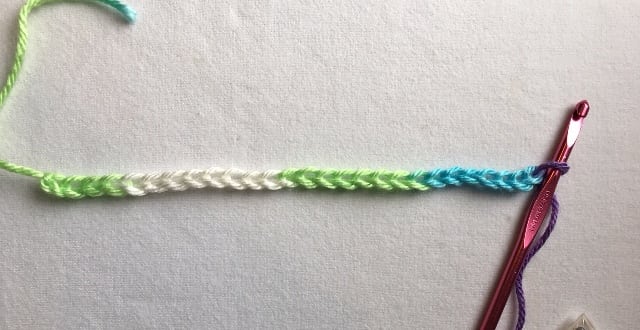Planned Pooling Crochet: How to Pick the Best Planned Pooling Crochet Hook Size
 Today we have a special guest on the blog. Please welcome back Brenda-Leigh who is here today to teach us about picking the best planned pooling crochet hook size for your next project.
Today we have a special guest on the blog. Please welcome back Brenda-Leigh who is here today to teach us about picking the best planned pooling crochet hook size for your next project.
When you are starting a planned pooling project and using a new color, it is always best to start with a swatch first. I know, I know – we all hate doing a gauge swatch, but trust me, you want to do one for your pooling projects. There are 3 reasons why making a swatch is worth the time in a pooling project.
Three Reasons Why to Swatch in Planned Pooling Crochet:
- Choosing the best hook size
- Choosing the color placement
- Deciding where to create your offset
This tutorial will address choosing the best planed pooling crochet hook size. Look for the next two reasons to swatch for planned pooling coming to the blog soon!
*This post contains affiliate links. By clicking one of these links and making a purchase a small portion of your purchase will go to the blog, but the price you pay will not change. Thank you for your support of the blog.*
Tutorial Materials:
For this tutorial, I will be using Red Heart Soft Baby Steps in Tickle. Making a swatch for planned pooling isn’t quite the same as making one to check gauge.

I am using the Susan Bates Silvalume crochet hook set, as they are my favorite and I find the finish moves very smoothly through any yarn.
I always start with the hook recommended on the yarn label. In this case, that is a 5.5 mm (I) hook. Start with a foundation chain of between 18 and 25 without worrying about where you start in the color sequence. You can work your first row into the chain, around the chain, or into the spine as you please; we won’t be looking at the first row anyway, so do what is most comfortable.

Using the 5.5 mm hook, work in moss stitch the entire length of your chain and through at least three full sequences, not counting row one. Work these rows using your normal, most comfortable tension. I find sitting in my “crochet” chair with a cool beverage nearby works best.
Working at your most comfortable tension will help us identify which hook will give you the least amount of manual tension adjustment in your actual project. That means less vigil is required and you will have way fewer stitches to tear out and do over. And over, and over.
Let’s take a look at the rows done with the 5.5 mm hook.


You can see there are many instances where the stitches are different colors on each ‘leg.’ I always check both sides because it happens frequently that a stitch will look fine on one side and be split colors on the other side. If I choose to move forward with this hook, I know I will have to be making constant adjustments and tearing stitches out to get single color stitches.
After trying the suggested hook, I like to go to the next larger one rather than the next smaller one, so in this case that is the 6 mm (J) hook. I am going to chain however many I need to have the next hook size start with a distinct color change. You can see here I have had to chain several stitches to get to the lime green. Since we will take this swatch apart after it has served its purpose, wobbly and wonky ends are okay.

Again, work through several sequences at your normal, relaxed tension with the 6 mm hook. You may find it helpful to use a stitch marker on the first stitch completed with each hook size. Let’s take a look at the stitches here and again, we can see many stitches with different colors within one stitch. Additionally for this hook, I find the fabric to be very loose and less pleasing; however, that is a personal choice.


Since the larger hook didn’t work, I will now try the next smaller one, which is the 5 mm (H). Again, work through at least three full sequences at your most comfortable tension.


Looking at the rows completed with the 5 mm hook, we can see there are far fewer split color stitches. Looking at this section here, you can see I have 2 lime stitches, 1 half lime half white, 2 white, another half lime half white and 2 more lime.

To resolve it, I would have to tighten up the first lime section to get three full stitches, or loosen it to give that yarn to the white stitch. Then I have to do the same thing again for the second lime section. I would most likely end up with 3 tight lime, 3 natural tension white, 3 tight lime. I don’t like having to tighten the tension to make the pooling work because there is only so much you can do before you run out of that color.
Most of the time when I do a swatch, I find my hook in the first three. In this case, I am not happy with the results of the five so before I start my Tickle Me Blanket, I am going to try the next smaller hook, which is the 4 mm (6).


Right away I can see I am almost getting 3 of each color using my natural tension. There are a few split color stitches, but not as many as some of the other hooks sizes. Here is an example where one side looks great, but the other has a few split stitches.
In this case, either the 5 mm or the 4 mm hook will work for this project.
Things to consider when choosing planned pooling crochet hook size:
- The 5 mm requires tighter stitches in places
- It is easier to use up yarn, than to make yarn available
I personally tend to crochet loosely, so I will have to be very vigilant if using the 5mm. I also love the idea of having all of the colors the same number of stitches (4 mm hook). Before I make my final decision, I am going to work a few rows in the 4 mm, paying attention and adjusting as necessary to see how it will feel when working the project.

NOTE: The orange stitch marker is the beginning of using the size 4 hook and the blue shows where I was trying to manage the stitch counts.
I find I can achieve 3 stitches of each color with a little extra attention and the stitches are comfortably loose for me. I have my hook size and one very funky looking swatch.
The extra work in choosing the right hook was well worth my time. The process for making the swatch only took me about 15 minutes, but it saved me hours of frustration trying to get a yarn to pool with the wrong hook size. The resulting fabric and blanket was worth the time it took to find my hook size.

Only you can determine the right hook size for you for any given color you wish to pool.
Planned Pooling Crochet Blog Posts with Marly Bird:
Thanks so much to Brenda-Leigh for sharing with us why picking the right hook size is important for planned pooling crochet. If you want to learn more about Crochet Planned Pooling you can view my other posts on how to use the moss stitch.
- The Best Crochet Planned Pooling Argyle Tutorial
- 10 Secrets to Perfect Planned Pooling in Crochet
- Planned Pooling-Finished Starting Chains
- How to create Crochet Planned Pooling Argyle Charts
- Multiple Sequence Planned Pooling Crochet
- Granny Stitch Planned Pooling Crochet
About Brenda-Leigh:
My name is Brenda-Leigh and I taught myself how to knit when I was seven using a book. Shortly after I began knitting my mother wanted to learn as well so I taught her. It was a great bonding experience to be able to show her something I had learned.
When I was eleven I taught myself how to crochet and my first project was a pineapple doily made with crochet thread.
I’ve continued with both over the years and have recently fallen in love with crochet. When planned pooling became popular last fall, I caught on right away and have had to opportunity to teach others. Since that early experience with my mother, I’ve loved being able to teach others and witness their success. Nothing makes me happier than giving someone that “aha!” moment.
You can find me on Ravelry as CrochetbyAlexina.
Yarn Pooling Made Easy by Marly Bird:
Did you know that Marly has published a book on Planned Pooling Crochet? In this book, published by Leisure Arts, you will find 10 beautiful designed patterns that you can create using Red Heart yarns.














